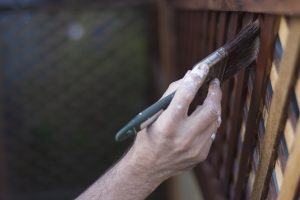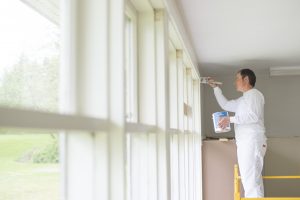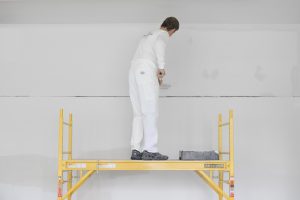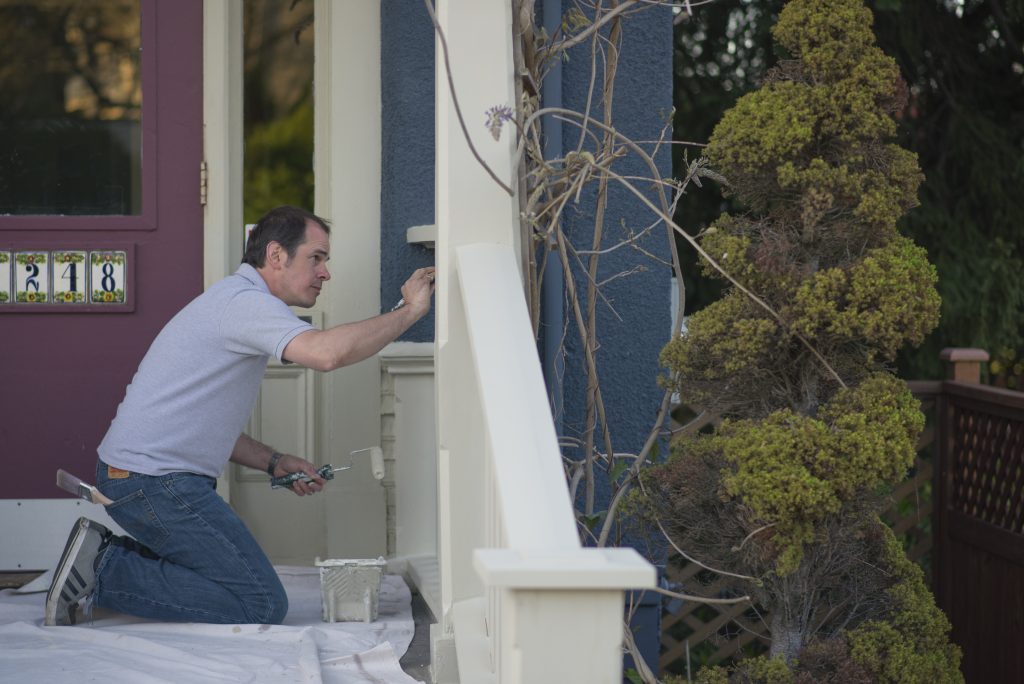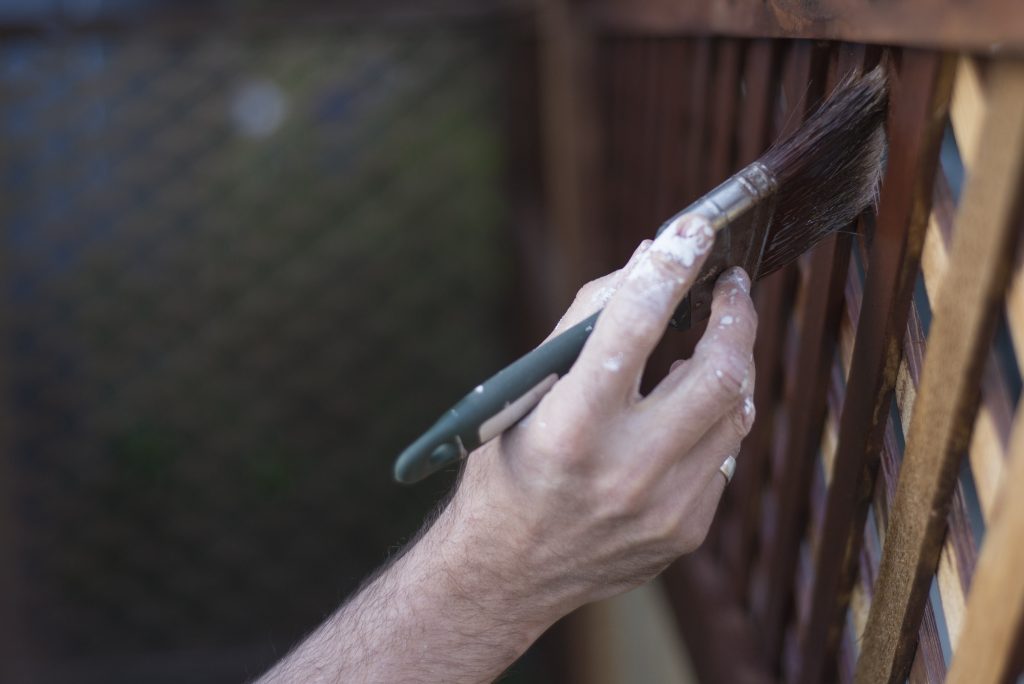How one west coast painter stays profitable, energized and true to himself.
Simon Kuhl is the kind of guy who does a lot of things well, and managing his life as a painter is one of them. He owns Sombrio Painting (sombriopainting.com) on Vancouver Island, and his story is as much about aiming for a balanced professional life as it is about running a profitable painting enterprise. Simon is not the kind of guy who’s content to let his business run him, and his experiences have something to teach anyone who wants more than just a 9 to 5 work experience as a painter. As a family man
he’s got a bottom line to meet, as well as interests, passions and experiences that need to get their time, too. This story is about how one Canadian painter strives to make all these things happen in a beautiful part of our country.
Simon’s specialty is craftsman quality interior and exterior painting of residential and small commercial projects. He’s also into wood finishing and refinishing, restoration and custom projects that require a careful eye. And like a lot of people worth learning from, Simon’s work today is an extension of his past.
“While growing up, my dad painted on the side for a few years and so I got a little exposure to the trade that way”, remembers Simon. “In my teens I wanted to become self employed entrepreneur (I actually put that in my junior high yearbook as the answer to what I wanted to do for work when I grew up). I had this idea of owning a truck, running around serving my painting clients. But in my twenties I got involved in the wine industry in Alberta. I had a great experience, learned a lot about wine and spirits, but mostly about customer service, sales, and accountability. These skills serve me well today as a painter. After 10 years of wine, I needed a change. My wife and I moved to Penticton, BC, scrounged to find any job I could, and had the good fortune of being fired from a job I really disliked. That opened the door to entrepreneurship via a government program that provided a modest income and mentorship while completing an intense 3 week comprehensive business plan workshop. That early support was incredibly valuable and I continue to benefit from it. My brother-in-law is a 30-year pro-painter. He taught me and still teaches me a lot about the technical side of painting and about how to make money in the trade.”
Sidebar: More Than Painting
Simon Kuhl is a creative man, and this fact extends beyond his work as a painter. His blog at microcontractor.org is one of the best you’ll find anywhere. It’s worth reading because it combines valuable insights into what it takes to run a small trade business well, while staying sane. “I’m allergic to chaos and unreasonableness”, explains Simon, “so I’m sensitive to situations where someone is trying to impose those into my work life and I try to set boundaries.” His blog explains how to do this and more. It’s a by-product of my day to day painting business and a way to create value for a whole other market.
Good painters often have a good eye, and that’s probably why Simon’s photos are good enough that people hire him for weddings, engagements, anniversaries and portraits. You’ll be impressed by his work at kuhlphoto.ca.
After Simon ran his successful painting business in the South Okanagan valley for 10 years, he realized it was time for another change. “Most of the objectives I could have dreamed for my little business were achieved”, explains Simon. “10 years in business, $1 million in total sales, a happy customer base of 300+, good relations with suppliers and competitors. But looking forward 10 years I didn’t want to be in the same place.”

Some of the challenge and aspirations that originally energized Simon were gone. As he tells the story, “there was a lot of resistance in our life at that time. I needed a new challenge and opportunity. We needed to find a community that was better suited to raising a family. I wanted to sell my business to extract some of the value that I’d worked hard to create. I wanted to mentor young painters and help them grow and learn as much as I had. I wanted to try and get back into the workforce before I felt like it was too late (body breaking down, skills too narrow or obsolete, etc). So we took a risk again and moved to Victoria, BC, on Vancouver Island.”
That’s where Simon took a job with a major paint manufacturer. “I learned a ton, but after 6 months it was clear that this job wasn’t right for me. Construction is booming here so I went back to doing what I know best and started a new business from scratch. This was an interesting experience because it is much smoother the second time around, and in a bigger market the growth came faster, with less mistakes. We’ve already surpassed our peak sales numbers from the previous business.”
When Simon says “we”, he doesn’t mean himself and some employees. He found out the hard way that the employee model didn’t work for him. “There was a time when I hired employees, and it really changed my business. After the first three years on my own, I hired painters and a bookkeeper to do payroll. My business immediately went from being in the black to going into the red. I much prefer the simplicity and flexibility of having subcontractors.”
These days Simon’s painting enterprise involves a varied list of situations, making use of sub contractors as the need and the need arises. In Penticton he did a lot of residential repaints, with a select few custom home new construction jobs. There was small and medium-sized commercial jobs, insurance work and spec homes, but the mainstays of the business were residential repaints and custom homes. In Victoria the work is mostly insurance and restoration, general contractor reno painting, and residential repainting.

“I always strive to exceed expectations in service and quality. These are the only two things we can really control, and it goes beyond just applying paint. In talking with many successful business people over the years, it has become clear that the secret to success is how you treat people. Sounds simple, but that’s what it comes down to. Aside from that, my favourite mantra is a quote from Pablo Picaso: ‘Action is the foundational key to success.’ Always move the ball forward somehow.”
One of the best ways of learning from a business is by looking at the challenges it faces and the solutions that arise. In the case of Simon, his three main challenges include: scaling up, scheduling and keeping work in its place.
“I know its very possible to grow beyond the work that two or three painters can handle because a lot of companies grow way beyond this size. I do the best I can in my comfort zone, rather than push to grow and not have it be manageable. But it would be nice to figure out the secret to breaking through the mental barrier I have. For now, I’m content to stay small. Many smarter and more experienced people tell me to stay small. They say it’s more profitable and less stressful. I just have this internal programming where I feel like I always has to be getting bigger, and this makes for an internal struggle. Part of this may have to do with scheduling. I’m still underestimating how long projects take, not allocating slack for extras and over-booking.”
Keeping work in its place is another ongoing challenge for Simon, as it is for many small business owners. “Painting and running the business could easily fill my weekdays from 7am to 7pm and beyond if I let it. This doesn’t leave much time for family, which frustrates me to no end. I’m always looking for ways to reduce the footprint my business takes up in my life.”
When Simon talks about sub contracting, it’s not just about painters. “Over the past 3+ years I’ve teamed up with a good drywall repair specialist, both in Penticton and now here in Victoria. We send work each other’s way. Here in Vic I take on quite a few jobs that require insulation, boarding, taping and painting. Being able to take on projects that go beyond painting gives me the flexibility to start jobs quickly and to have multiple jobs on the go at the same time. It works well. I don’t make as much on the drywall portion, but I can take on and manage multiple jobs while delivering great service and quality. As for painters, having them on a sub-contracting basis is essential. Their labour is a cost of sales allocated to each job rather than being business overhead as if they were on payroll. Sub contracting also keeps the arrangement flexible and fluid. If a painter needs time off, all I ask is for a little notice to adjust our schedule. I give up some control but it is well worth the flexibility. We have an understanding that if they prioritize the work I have for them, then I will continue to offer them right of first refusal on my extra work. So far my sweet spot is having two part time painters besides myself. This way I don’t have to do all the work, but I still get to paint on most projects and maintain a presence on site. I prefer to work by myself on Mondays, whereas Tuesday through Friday is full production days. I’ve gotten to the stage where I generally don’t work evenings and weekends and can take most long weekends off.
Sidelines That Pay
One of the ways Simon adds variety to is work is by taking on jobs related to painting but different. Interior wall plastering with clay is one example. “I generally use products by a company called American Clay (www.americanclay.com; 866.404.1634). It comes as a powder that you mix with water, then trowel on. It’s natural, beautiful, timeless, temperature and moisture regulating, and easy to repair. It repels dust and absorbs oils from hands, it releases negative ions into the air which are good for our well being, and it never fades and never needs painting. I recommend clay walls for wineries, spas, and custom homes where clients want an alternative to paint in some areas. So often with custom homes the client puts a lot of thought into picking the right piece of granite for the countertops, the right faucets and lighting fixtures, even special door hardware, then they just paint all the walls beige. Many people don’t realize there are options for their walls beyond paint.”
Wood finishing is another of Simon’s specialties. “For simple furniture refinishing I use the Saman stain line or Varathane for custom stairs and interior woodwork. For exterior applications I prefer Penofin Marine Oil for beams, new decks and fences. I’ve given up on film-forming clear coats for exterior applications because sooner or later they peel. For solid stain I use Super Deck or Arbor Coat.
The restoration work we do is over-flow from local restoration companies. They send us their extra drywall, trim and painting work. It’s a valuable business builder for us as the margins are pretty good. There’s more work in the off-season, and we get spin-off jobs from the homeowners and their neighbours and friends.”
Simon is quick to point out that his business is not a model of success compared to many other painting businesses, or even compared to the potential in the market. “I don’t yet feel like I’ve even attained my own modest definition of success”, explains Simon. “But I’m getting closer than ever and the experience has taught me so much.”
Q&A With Simon Kuhl
 Q: What are your favourite time management strategies?
Q: What are your favourite time management strategies?
A: Write stuff down in The Book. Delegate as much as you can. Focus on one or two main things for the day. Keep paperwork organized. (I learned a principle long ago that you should be able to find any document in 2 minutes or less.) Stay up to date with bills and taxes. Set a weekly schedule. I estimate on Friday afternoons, check mail, do bank deposits, pay bills on Friday evening. Mondays I work by myself to set up the week. i don’t take a lot of breaks, don’t answer the phone much during the day, try not to leave the site for materials, coffee, estimates, etc. Starting and stopping kills effectiveness.
Q: How do you decide who to contract with?
A: For sub-contractors I always choose character over skill. For general contractors I choose to work for, the main factor here is trust. It takes time to build trust over successful projects.
Q: How do you decide which clients to accept or reject?
A: Quality attracts quality. My branding and prices communicate certain values that repel incompatible customers and attract the right ones. I won’t work with unreasonableness. Most of my work is repeats and referrals from satisfied customers.
Q: What’s the toughest painting job you’ve had?
A: Poplar Grove Winery. The day I was awarded the contract I traded in my work truck for a new family vehicle. Scheduling was crazy-making. They were several weeks behind by the time the painting started, and they were not going to adjust the completion date. So we were working around other trades – some were still there that should have been finished, some were there that should not have been starting yet. That puts a lot of pressure on the painters. We were trying to paint while the drywallers were trying to finish the walls and the electrician was installing lights. Often there would be five tradespeople trying to work in the same 10 square feet. We had half the time we needed and the work was taking more than twice as long as it should have. I almost fell off a double section of bakers racks as I forgot to lock the wheels. Fortunately one of our painters was close by and was able to run over and steady the scaffold. I was within 10 seconds of dropping 12′ onto a concrete floor. I think its important to note that in the end we completed the projected successfully and it became a show-piece facility in the city and for our portfolio. We received a nice referral from the builder.
Q: What’s your perfect work day?
A: In Penticton I had the pleasure of working with some of best friends and we’d sometimes get these large exterior wood staining projects up in the hills. The owners would often fresh baked muffins and coffee for us. We’d start at 7am to stay ahead of the heat, working in the shade as the day got warmer. By 3:00pm we’d cool off in Skaha Lake before heading home for the gorgeous Okanagan summer evenings.
Q: How do you keep good contractors interested in working with you?
A: Tell them how much you appreciate working with them. A micro business is a personal business. That’s it’s competitive advantage. I don’t believe the saying “it’s not personal, its just business”. Business is a transaction from one human to another and we’re all looking for decent human connections.
Q: What are your favourite technical things in the painting world?
A: I appreciate great coatings (great flow for production, great hide, great leveling, great adhesion, self-priming, low VOC, mildew resistant, interior/exterior capability) and I’m liking flatter sheens more and more. Health is really important to me. With a a bucket under my chin all day, I want to make sure the paint is as clean as possible. Some of my current interior coatings of choice are BM Regal Select, Cloverdale Super II, and S-W Solo.
Q: What are your aims for the future?
A: I’m always looking for new ways to improve and create more value for my family, my painters, my customers and other entrepreneurs on the same road I’m on. My blog www.microcontractor.org is part of this. It helps me reflect on experiences and it lets me pass on what I’ve learned to other painters on a similar path. I think that entrepreneurial success goes beyond problem solving and value creation, to the separation of time from income. Time is infinitely more valuable than money, so if we are seeking to create maximum value, it must include using our business to create more time for ourselves. This is a difficult pursuit, but beyond survival, it has to be one of the main reasons we all got into business in the first place – to earn our freedom. If we don’t realize that goal of time freedom, than it is doubly troubling because we have no one to blame but ourselves. Its an ongoing struggle for me, but it is my main goal for my business going forward.


